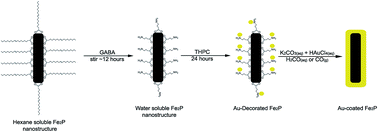Gold coated iron phosphide core–shell structures†
Abstract
Core–shell particles Fe2P@Au have been prepared beginning with Fe2P nanorods, nanocrosses and nanobundles prepared from the solvothermal decomposition of H2Fe3(CO)9(μ3-PtBu). Iron phosphide structures can be produced from a single-source organometallic precursor with morphological control by varying the surfactant conditions to yield fiber bundles and dumbbell-shaped bundles ranging from nanometers to microns. Derivatization of the surfaces with γ-aminobutyric acid was used to attach Au nanoparticle seeds to the surface of the Fe2P nanoparticles followed by completion of the Au shell by reduction with formaldehyde or aqueous HAuCl4/CO, with the latter giving somewhat better results. Shell thickness ranged from an incomplete, partially coated Au shell to a thickness of 65 ± 21 nm by varying the amount of gold decorated precursor particles. Increasing the thicknesses of the Au shells produced a redshift in the plasmonic resonance of the resulting structures as was observed previously for FeOx@Au.



 Please wait while we load your content...
Please wait while we load your content...